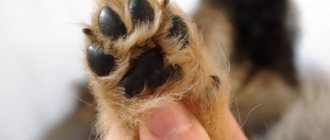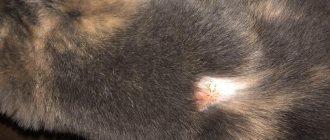Cysts, adenomas and adenocarcinomas of the sebaceous glands
Sebaceous cysts are common types of skin cysts that contain sebum, a thick, oily material typically found in the skin around hair follicles.
These formations can be on any part of the body. Sebaceous cysts are benign, but they can also be mistaken for a malignant tumor called sebaceous adenocarcinoma or a benign growth called sebaceous adenoma.
If the cyst is not bothering your dog, your veterinarian can leave him alone, but if necessary, the cyst can be removed surgically.
Once removed, the cyst should be sent to a laboratory so that a veterinary pathologist can determine that it is indeed just a sebaceous cyst, adenoma, or adenocarcinoma, which may require additional treatment.
Associated symptoms
Benign formations
should not be accompanied by any additional symptoms.
Malignant formations
, on the contrary, will worsen the pet’s quality of life. Usually in the early stages the dog does not experience obvious discomfort. As the formation grows and progresses, the pet may feel pain and weakness. Tumors often metastasize to the lungs, after which the animal will have difficulty breathing and shortness of breath. The tumor can spread to many organs and tissues, which leads to a decrease in their performance and the death of the animal.
Abscess
can often be accompanied by increased body temperature, lethargy, and refusal to eat.
The abscess itself is painful to the touch and gives the pet discomfort. Allergies
can go from harmless rashes all over the body to life-threatening swelling of the respiratory tract.
A small, non-strangulated hernia
usually does not cause discomfort to the animal. When the hernial ring is pinched, it becomes painful and hard. With prolonged compression, the tissues die and the pet may die.
Oral growth in dogs
Various growths can form in your dog's mouth. Some growths are difficult to see but cause symptoms such as bad breath, trouble chewing, difficulty holding objects in the mouth, oral pain, and scratching marks on the face or mouth. Of course, these signs can also indicate dental disease and should not be ignored.
Papillomas are warts caused by the papilloma virus. They can appear on the dog's lips, face and mouth. Papillomas are benign, but very contagious. They can be removed if they are causing problems for your dog, but in many cases they will resolve on their own.
An epulis is an oral growth that usually forms on the gum tissue around a tooth. Many epulids are benign, but some may be malignant, so further diagnosis is necessary.
Gingival hyperplasia is a benign growth of gum tissue that can look a bit like a tumor in some dogs. This excess gum tissue can be removed if it is affecting the teeth or bothering the dog. The removed tissue may be sent to a veterinary pathologist to ensure there are no cancer cells.
Oral melanoma can occur in the mouth and may be black in color.
Squamous cell carcinoma and fibrosarcoma are other common types of cancer that can develop in dogs' mouths.
Some oral tumors can affect the teeth and bones in the mouth and face. If your dog has a mass in his mouth, your veterinarian will likely recommend placing him under anesthesia so that a thorough examination and x-rays can be taken.
Causes
The disease occurs against the background of a weakening of the body's protective functions. Low immunity is unable to cope with pathogenic microflora, which is always present in a certain amount on the animal’s skin, so it begins to actively multiply.
It is very important to diagnose the disease on time. Only in this case can you fight not the consequence, but the true cause of pododermatitis.
Main reasons:
- parasitic infections, the presence of mites or helminths (scabies, soil nematodes);
- fungal skin diseases;
- allergic contact dermatitis or general allergic reaction;
- autoimmune disorders (systemic lupus erythematosus, erythema, vasculitis);
- hormonal disorders, diseases of the endocrine system;
- oncological diseases.
In addition to illness, lameness and painful sensations in the paws can be caused by:
- injuries, cracks;
- sharp objects stuck into the skin while walking;
- irritation from prolonged contact with asphalt or other surfaces.
Lipomas in dogs
Lipomas are a common type of tumor in dogs. A lipoma is a benign fatty mass that can be found anywhere on a dog's body, usually under the skin. They are usually soft and flexible and rarely cause pain or discomfort to the dog.
Lipomas can be removed surgically if they interfere with your dog's mobility or comfort, grow quickly, or rupture (causing damage to the skin). In rare cases, an apparent lipoma is actually a malignant tumor called liposarcoma. Diagnostic testing can distinguish them.
Allergic reactions
Of course, allergies can manifest themselves in the most unpredictable, sometimes even very original and bizarre ways.
In particular, in dogs it often manifests itself in the form of bumps on the paws. The reaction may be to insect bites such as ticks, mosquitoes or fleas, or to injections, alternatively, during vaccinations. It is worth understanding that these types of symptoms go away quite quickly on their own. However, in cases where this does not happen, it is necessary to seek advice from a veterinary clinic. It is advisable to do the same if the dog has active itching at the site where the lump appears.
Hematomas and warts
Fat cell tumors in dogs
Fat cell tumors can appear as bumps on the skin or internal tumors. These growths can release histamine if disturbed, which can have negative effects on your dog's body.
If your vet suspects a fat cell tumor, your dog may first be treated with diphenhydramine to minimize histamine release.
After removing the mass, the pathologist grades the tumor as I, II or II. This score tells you how cancerous the tumor is and how likely it is to metastasize (spread to other parts of your dog's body).
Content
1. Causes of bumps on the paws of dogs 2. What does the color mean? 3. Allergic reactions 4. Appearance 5. Oncology 6. How to help a dog before visiting a veterinarian?
Any adequate pet owner from time to time examines his pet for the appearance of various injuries, injuries, as well as neoplasms. And at some point in time, the owner may notice bumps on the dog’s paws. These formations can be very different, both in color and size, and in the pain they cause. However, in any case, this issue must be taken as seriously and responsibly as possible. It is important to correctly diagnose the causes and prescribe timely, effective treatment.
Internal tumors
Some dogs develop internal masses in the chest or abdomen, especially older dogs. Internal masses may be discovered because of the symptoms they cause (such as difficulty breathing or vomiting) or during a routine medical examination.
Internal lesions can be benign or malignant and are usually definitively diagnosed through a combination of x-rays, ultrasound, laboratory tests, and biopsy. Treatment depends on the location and type of tumor.
Pododermatitis
Pododermatitis is a disease of the paw pads that causes growths and bleeding swellings to form between the toes. This causes pain and discomfort to the dog, so it lies more than moves, and when moving it limps and whines.
The risk group includes:
- Labradors;
- German Shepherds;
- Shar-Pei;
- dachshunds;
- bulldogs.
The listed breeds have a predisposition to pododermatitis. The disease can only be treated by a veterinarian. In advanced cases, it depletes the joints and leads to the death of the pet.
In parallel with treatment, it will be necessary to review the dog’s diet and living conditions. Pododermatitis often develops as a result of an unbalanced diet or a long stay of the animal in a damp, cold place.
Interdigital pododermatitis in a dog
Lymphoma in dogs
Lymphoma is not actually a tumor; it is a cancer of certain cells of the immune system. However, the first sign of lymphoma is often swollen lymph nodes, which may look and feel like tumors. 4
Pet owners most often notice lumps in the neck area, but they can also be found in the armpits (armpits), groin area (lower abdomen near the hips), and the back of the knees. Lymphoma is often diagnosed by fine needle aspiration or biopsy. Chemotherapy is the most common treatment for lymphoma.
Diagnostics
Diagnosis begins with collecting anamnesis, finding out when the lump first appeared and how quickly it grew. Next, the pet is carefully examined, the formations are probed for density, mobility, and pain for the animal. Superficial lymph nodes are also palpable. The cytological diagnostic method is often used. Using a needle and syringe, cells are sucked out of the formation, which are then placed on a glass slide. The material is stained and carefully examined under a microscope. Cytology can usually make a preliminary diagnosis. In many cases, a biopsy and histological examination are necessary to make a final diagnosis. This procedure is more complex and takes more time to obtain results. If your pet is scheduled to undergo surgery to remove a tumor, your doctor may recommend magnetic resonance imaging.
Diagnostic process
When a tumor is found, your veterinarian will perform a physical examination. If the mass is very new and potentially temporary (such as the result of an insect bite or injection), your veterinarian may recommend a period of observation, but in most cases he will do additional diagnostics to determine the type of cells that make up the mass.
This usually means collecting a sample of material from the mass and analyzing it under a microscope.
The veterinarian usually collects these samples using fine-needle aspiration or biopsy. Evaluation of the specimens (often performed by a pathologist) can indicate whether the growth is cancerous and, if so, what type of cancer is present.
If your veterinarian diagnoses your dog with cancer, additional diagnostics will likely be recommended, including:
- Laboratory tests such as blood chemistry, complete blood count, and urinalysis.
- Radiographs (x-rays), which may show signs of metastases or other problems.
- Ultrasound, which allows you to better view internal organs and identify metastases.
- A CT or MRI scan can help veterinarians better understand the structure of your dog's tumor and some of its internal organs.
Some advanced diagnostics and treatments should be performed by a veterinarian.
What does the color say?
Lumps on a dog's paw can come in a variety of colors. And some information about the problem can be obtained from the color of the bulge.
| Red | If there is swelling and/or puffiness, it indicates a possible abscess, an allergic reaction, for example to a tick bite or a medicine. We can also talk about a malignant tumor. |
| Pink | In this particular case, with a high degree of probability we are talking about papillomas or malignant, as well as benign neoplasms. For obvious reasons, only a qualified veterinarian can make an accurate diagnosis. But the soft texture of a lump on a dog's paw indicates that the tumor is most likely benign and operable. |
| Black | This may turn out to be an ordinary hematoma or wart, or a cyst. |
Why all this reasoning? You cannot use any therapeutic actions, for example, warming up with external heat sources, opening swellings, even applying any ointments is highly discouraged. And not only because dog owners, as a rule, do not have the appropriate experience and skills, but rather, this is due to the fact that treatment errors with an incorrect diagnosis are fraught with serious consequences, even death.
Abscess
Abscesses most often appear on the surface of the skin, but there can also be an internal abscess, which is more severe and complex. Growths associated with infection appear as a result of mechanical trauma, cuts, and scratches. In this case, dirt, debris, wood, and glass may get onto the damaged area. Naturally, inflammation and abscess follow. Subcutaneous mites are also often the cause of the growth.
Under no circumstances should you open up lumps on your dog’s paws that are caused by an abscess. The fact is that the wound contains a large number of microbes, bacteria, and other pathogenic organisms. If opened incorrectly, they may enter the bloodstream. In this case, they will spread throughout the body, quickly affecting healthy cells and organs. As a result, the likelihood of blood poisoning and death is extremely high. Just like that, they simply opened the appendix, and the result was disastrous.
Conclusion: contact a veterinary clinic, where the operation will be performed by professionals using sterile instruments and materials.
Pododermatitis
Extremely unpleasant growths and swellings can form between the toes of dogs with pododermatitis.
The most important thing is that they do not just cause some discomfort, but cause real pain. As a result, the pet becomes inactive and prefers to lie quietly. If necessary, he begins to limp and sometimes even whine pitifully.
There is a certain risk group for breeds for which bumps on the paws of dogs in the form of pododermatitis are most relevant.
Among them are: Labradors, shepherds, primarily German, bulldogs and some others.
Owners of representatives of such breeds need to regularly, more often than usual, inspect the llama's pads and the space between the toes.
In the process of treating this disease, owners will be asked to radically reconsider the conditions of keeping the animal. In the vast majority of cases, the problem becomes urgent due to poor nutrition, lack of necessary vitamins, amino acids, and the dog’s constant presence in a damp room.
When does your dog need a biopsy?
If fine needle aspiration is not effective (or if the veterinarian feels it is not the best option), the next recommendation is usually a biopsy.
The biopsy is often performed on the dog under general anesthesia or sedation, but local anesthesia may be used instead depending on the size and location of the mass.
A biopsy can be performed using a special large needle. Or the veterinarian may surgically cut the mass. In some cases, the entire mass is surgically removed and sent to a laboratory for identification.
The danger of calluses for an animal
Many owners do not consult a doctor when they discover calluses, considering them a problem only from a cosmetic point of view. But calluses must be treated. When walking, they can cause pain and discomfort to the animal. The dog often licks wounds on the elbow joints and there is a risk of pathogenic bacteria and organisms getting into it, which will lead to inflammation and the development of callus dermatitis. In addition to rough, gray skin, if untreated, ulcers appear, accompanied by itching and pain.
How to prevent tumors, growths and cysts
Many lumps, cysts and growths cannot be prevented, but some can. For example, spaying your dog before her first heat cycle virtually eliminates the chance that she will develop mammary tumors.
In all cases, maintain a healthy diet and active lifestyle for your dog and visit your veterinarian at least once a year for preventative care.
Maintain a regular maintenance schedule and pay attention to any new bumps or bumps. A photograph and written report can help track growth, and if you notice rapid changes, contact your veterinarian immediately.
Prevention measures
The best prevention is careful adherence to the rules of keeping the animal - paw hygiene, organization of a healthy lifestyle, regular visits to the veterinarian.
To comply with these rules you must:
- promptly shorten overgrown claws;
- trim the hair growing between the toes and around the pillows;
- regularly deworm and destroy skin parasites;
- keep the dog clean;
- wash paws after walks.
Be attentive to your pet. The sooner you notice symptoms and take action, the sooner recovery will occur.
Traditional medicine recipes
You don’t always need to buy expensive medicines; you can try one of the following traditional medicine recipes:
- Mix aloe juice, fish oil and vitamin E.
- Make a puree of raw potatoes with onions.
- Grate raw potatoes and add honey.
Mix all ingredients in equal proportions and apply to damaged skin throughout the day. It is useful to apply propolis heated in your hands to calluses. Coconut oil, currently popular in cosmetology, can also be rubbed in for 2-3 minutes to soften the callus and speed up the healing process.











